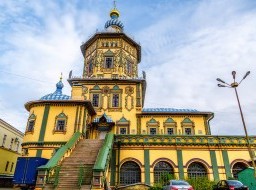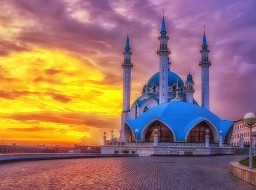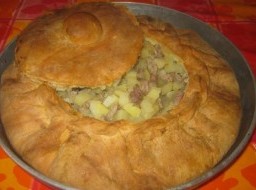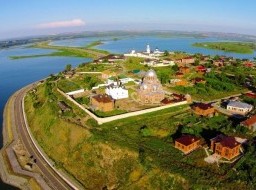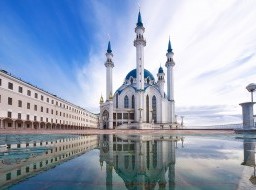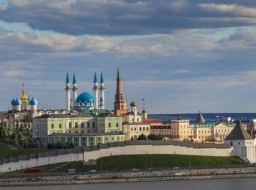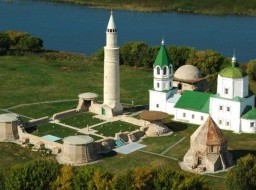The street got its current name at the very end of the last century, in connection with the 100th anniversary of the birth of the great geometer. Now, unless the old-timers remember that at its very beginning the huge Resurrection Cathedral once stood with five gilded domes, visible from anywhere in the city. The cathedral was famous not only for its architecture, but also for the beautiful choir led by the teacher of the theological seminary I. Morev. It is noteworthy that after the revolution this choir preferred to perform the proletarian anthem "Internationale" in the assembly hall of the university, and its leader became a teacher in the Eastern Musical College (now Kazan Musical College).
Now on the site of the Resurrection Cathedral there is a building of the chemical faculty of KSU. This is where Lobachevsky Street begins.
In a large building opposite, where the Kazan branch of the Academy of Sciences of the USSR is now located, which now has its present appearance as a result of a thorough reconstruction and reconstruction of several houses connected together, the Xenia gymnasium was located.
Mikhailov's rooms (house number 3), chosen before the revolution for some reason by the actors, have already been mentioned in previous notes. It remains to add that the famous for the whole of Russia V. Andreev-Burlak died here.
It is curious that in the small beautiful building of the store "Flowers" on the Black Lake used to be traded with flowers. Actually, for this purpose it was built. And before that, flowers were traded in the corner house No. 6, where the republican society of sobriety is now based. At one time in this house the well-known doctor R. Luria was lodging.
House number 10 was built in the 60s of the last century. Very interesting story of this site. His elderly owner in the middle of the last century rented rooms in the mezzanine floor of the house standing here for the students, among them A. Pypin, a cousin of the writer-democrat N. G. Chernyshevsky, who later became a famous historian and researcher of literature. Then the house moved to the family of the rich Old Believer Matvey Poduruev, who built the now existing beautiful mansion on the site of the old semi-stone building in 1906, designed by the famous architect F. Amlong. It should be added that in the formidable 1905-1903 the editorial office of the Volzhsky Vestnik, soon covered by the authorities for "sedition," was located here.
No less interesting is the house of L. Nalchikova (for her husband Likhacheva) at the corner of the present street of Karl Marx (№10). For a long time it represented the center of musical education in Kazan - it housed the music school of R. Hummert. Rudolf Avgustovich graduated from the St. Petersburg Conservatory in the class of Professor Miklashevsky. The theory of composition, he was engaged in the very Rimsky-Korsakov. After graduating from the conservatory in 1837, R. Hummert became an assistant in A. Orlov-Sokolsky in Kazan for conducting the opera. And he was recommended by A. Rubinshtein.
In 1891, R. Hammert founded his own music school, which was transferred to the Russian Music Society in 1904. Many outstanding musicians saw that house. It was taught by Julian Zakrzewski, Karl Russ, Xavier Korbut, Osip Rodzieb ... The current admirer of the rich cultural heritage of Kazan is somewhat disappointed by the lack of an accessible essay on the history of musical life and education of that time. I would like to hope that the interesting researches of the assistant professor of the Kazan State Conservatory G. Kantor scattered throughout many periodicals of the republic will finally be gathered together and will find the way to a broad reader.
In the three-story house (No. 9) Olga Staheeva, a relative of the owner of one of Russia's largest concerns, is known not so much for her connections with the "higher light"
how much its stormy, to put it mildly, life, there were a tobacco shop and a bookshop "Education".
House No. 11/12 at the corner of Karl Marx Street until the early 1970s belonged to Butlerova. And he was known, the so-called "Pokrovsky pharmacy" pharmacist Bening.
The whole length of the block to the street Bolshaya Krasnaya stretched the house M. Danilov. Much and many have seen them in their time. Before the First World War there lived an outstanding neuropathologist L. Darkshevich, a well-known lawyer and educator S. Ushakov, who took an active part in the social and political life of the city, after the revolution became a talented propagandist of the ideas of October, a teacher of many universities in Kazan.
Danilov baths at the end of the street were built in the late 70s of the last century and reconstructed after the revolution. That's baths and even a penchant for gambling and was known Mikhail Danilov. Only that was remembered in the newspaper obituary. A typical example of a typical representative of the class that the October Revolution dared to sooner.

